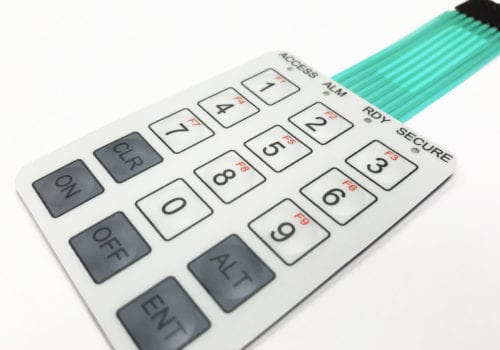Why Choosing the Right Membrane Switch Is Vital for Your Product Design
Why Choosing the Right Membrane Switch Is Vital for Your Product Design
Blog Article
Just How Membrane Switches Add To the Durability of Electronic Control Panels
Membrane layer buttons play an important role in improving the toughness of digital control panels, primarily through their multi-layered building which provides reliable protection against ecological elements such as dampness and dust. The lack of relocating components significantly decreases the chance of mechanical failures, making membrane changes ideal for demanding applications.
Definition of Membrane Switches

Membrane buttons are designed to be slim and lightweight, making them ideal for applications where space is restricted. They can be manufactured in various forms, sizes, and colors, using flexibility in layout that fulfills aesthetic and practical requirements. Additionally, membrane layer buttons can integrate various innovations, such as responsive feedback and LED indications, boosting customer experience.
Due to their construction, membrane layer switches are usually immune to dirt, dampness, and general wear, adding to their durability popular environments. Their seamless design not just assists in simple cleaning but likewise reduces the risk of mechanical failure, making them a preferred choice for manufacturers seeking dependable interface in their electronic control panels.
Security Versus Ecological Aspects
The layout of membrane changes naturally gives a level of protection versus different ecological elements, which is crucial for preserving performance in tough conditions - Membrane Switch. These buttons are usually created with layers of versatile materials that shield internal components from moisture, dust, and impurities. By enveloping the circuitry, membrane layer changes reduce the danger of brief circuits and rust, which can dramatically impair performance
In addition, the use of durable adhesives and sealers during production improves their resistance to environmental challenges. Membrane layer buttons can withstand exposure to chemicals and solvents, making them appropriate for markets such as food handling and health care, where hygiene and sanitation are vital. Their smooth surface style likewise stops the buildup of dust and germs, facilitating less complicated cleansing and maintenance.
Temperature variations are an additional environmental problem, and membrane layer buttons are engineered to function properly across a variety of temperature levels (Membrane Switch). This adaptability ensures that control panels stay operational in different setups, from industrial environments to customer electronics
Impact on Individual Communication
User interaction with digital control panels is considerably influenced by the style and capability of membrane layer switches. These switches offer a responsive user interface that boosts the total user experience, allowing for user-friendly navigation and control. Their receptive nature makes certain that customers receive immediate feedback upon activation, which is vital for jobs calling for accuracy and performance.
Moreover, the smooth surface of membrane switches helps with simple cleaning and maintenance, promoting individual confidence in the dependability of the interface. This tidiness More about the author is especially crucial in atmospheres where health is vital, such as clinical or food processing setups. In addition, the portable and light-weight style of membrane changes contributes to the aesthetic appeal of control panels, encouraging customer involvement via a published here modern-day and smooth look.
Additionally, the integration of aesthetic components, such as published icons and backlighting, aids individuals swiftly identify functions, decreasing the finding out curve connected with brand-new devices. Because of this, customers can operate devices better, causing raised performance and fulfillment. In summary, membrane layer switches play a critical role in boosting individual interaction by incorporating performance, looks, and convenience of usage, eventually resulting in improved operational performance.
Style Versatility and Customization
Style adaptability and modification are vital aspects of membrane layer switches, allowing manufacturers to customize digital control panels to details applications and user demands. This adaptability enables the integration of different layout elements, such as shades, graphics, and textures, which can improve the aesthetic appeal and individual involvement of the control panel.
Membrane layer buttons can be customized in dimension and form, accommodating a large range of gadgets and applications, from commercial equipment to consumer electronics. This convenience makes sure basics that manufacturers can produce instinctive user interfaces that align with individual assumptions and functional requirements. Additionally, the capability to integrate one-of-a-kind functions such as backlighting or tactile responses additionally boosts functionality, enabling a much more interactive experience.
In addition, the manufacturing procedure for membrane switches supports the rapid prototyping of styles, allowing makers to repeat and improve their principles promptly. This capability not just accelerates the development timeline but also guarantees that the last item satisfies certain useful and visual criteria.

Cost-Effectiveness and Long Life
Cost-effectiveness and long life are substantial benefits of membrane switches, making them an attractive alternative for suppliers and end-users alike. These buttons are normally cheaper to produce than traditional mechanical buttons, mostly because of their simplified manufacturing procedures and the minimized number of components called for. This expense advantage extends not just to preliminary manufacturing yet additionally to lasting operational costs, as membrane switches often require much less maintenance and have a lower failure rate.
Moreover, the long life of membrane layer switches adds to their general worth. Built from durable products, they are resistant to ecological elements such as moisture, dust, and chemicals, which can lead to early wear in other button kinds. The absence of relocating parts minimizes mechanical failing, allowing membrane layer switches to preserve functionality over extended durations.
This toughness is especially advantageous in applications calling for consistent efficiency under demanding conditions, such as clinical gadgets and commercial equipment. Inevitably, the mix of cost-effectiveness and durability makes membrane layer switches an economically sensible option for suppliers, offering trustworthy solutions that hold up against the test of time while enhancing financial considerations.
Final Thought
In conclusion, membrane switches dramatically enhance the sturdiness of electronic control panels via their durable building and construction and safety functions - Membrane Switch. Generally, membrane switches stand for a trusted and cost-efficient selection for boosting the durability and functionality of digital control systems.
Report this page